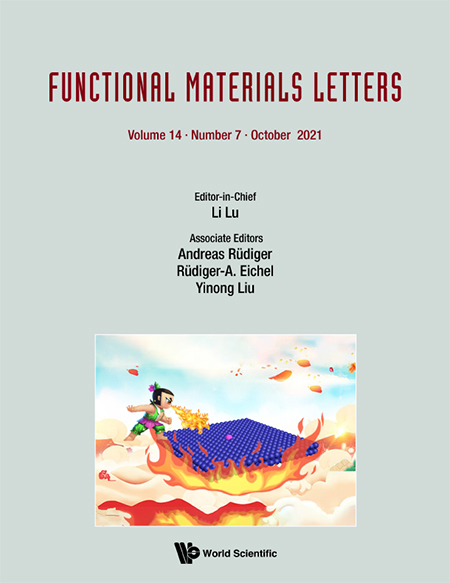An in-situ catalytic-insoluble strategy enabled by sulfurized polyacrylonitrile-based composite cathode for potassium–sulfur batteries
Abstract
Owing to the insoluble organosulfur mechanism and stable cycling life, sulfurized polyacrylonitrile (SPAN) developed as a promising cathode material for high-energy potassium–sulfur batteries (KSBs). However, it is yet a major challenge to achieve fast catalytic kinetics and high reversible capacity in SPAN-based cathodes. Here, one-step electrospun SPAN nanofibers embedded with FeNbO metal oxide nanoparticles (FeNb@SPAN) have been successfully developed to construct sulfur electrodes with high electrochemical activity, high sulfur utilization, and high cycling stability. The as-prepared freestanding FeNb@SPAN composite cathode, which featuring interwoven nanofibers with FeNbO nanoparticles homogeneously implanted, possesses high storage space for volume expansion and suppresses polysulfide dissolution during potassiation/depotassiation. Benefiting from its unique structure and composition in electrode design, the FeNb@SPAN cathode is endowed with outstanding energy storage performances with a high initial specific capacity of 776 mAh g under 50 mA g and an excellent cycling capability of 201 mAh g after 80 charge/discharge processes. This work heralds a feasible strategy toward SPAN-based sulfur host materials in the structural design of next-generation high-performance cathode materials for KSBs and other metal–sulfur batteries.
References
- 1. , Energy Environ. Sci. 13, 432 (2020). Crossref, Web of Science, Google Scholar
- 2. , Nano Res. (2021), https://doi.org/10.1007/s12274-021-3560-3. Google Scholar
- 3. , Adv. Funct. Mater. 31, 2102326 (2021). Crossref, Web of Science, Google Scholar
- 4. , ACS Nano 14, 9117 (2020). Crossref, Web of Science, Google Scholar
- 5. , Small 16, 2003386 (2020). Crossref, Web of Science, Google Scholar
- 6. , Electrochem. Energy Rev. 3, 613 (2020). Crossref, Google Scholar
- 7. , Adv. Energy Mater. 11, 2100770 (2021). Crossref, Web of Science, Google Scholar
- 8. , ACS Nano 14, 17308 (2020). Crossref, Web of Science, Google Scholar
- 9. , Angew. Chem., Int. Ed. 59, 10732 (2020). Crossref, Web of Science, Google Scholar
- 10. , Adv. Energy Mater. 11, 2003493 (2021). Crossref, Web of Science, Google Scholar
- 11. , J. Electron. Mater. 50, 3037 (2021). Crossref, Web of Science, Google Scholar
- 12. , Adv. Sci. 6, 1802130 (2019). Crossref, Google Scholar
- 13. , J. Mater. Chem. A 8, 5379 (2020). Crossref, Google Scholar
- 14. , Adv. Funct. Mater. 29, 1902929 (2019). Crossref, Web of Science, Google Scholar
- 15. , Chem. Commun. 54, 2288 (2018). Crossref, Web of Science, Google Scholar
- 16. , J. Mater. Chem. A 6, 14587 (2018). Crossref, Google Scholar
- 17. , ACS Appl. Mater. Interfaces 11, 29924 (2019). Crossref, Web of Science, Google Scholar
- 18. , J. Mater. Chem. 21, 6807 (2011). Crossref, Google Scholar
- 19. , J. Mater. Chem. A 5, 22120 (2017). Crossref, Google Scholar
- 20. , Chem. Commun. 55, 5267 (2019). Crossref, Web of Science, Google Scholar
- 21. , Adv. Energy Mater. 10, 2002076 (2020). Crossref, Web of Science, Google Scholar
- 22. , ACS Nano 14, 17285 (2020). Crossref, Web of Science, Google Scholar
- 23. , Inorg. Chem. Front. 6, 477 (2019). Crossref, Web of Science, Google Scholar
- 24. , Chem. Commun. 57, 1490 (2021). Crossref, Web of Science, Google Scholar
- 25. , InfoMat 3, 339 (2021). Crossref, Google Scholar
- 26. , Nat. Commun. 11, 1212 (2020). Crossref, Web of Science, Google Scholar
- 27. , Funct. Mater. Lett. 14, 2130006 (2021). Link, Web of Science, Google Scholar
- 28. , Adv. Mater. 32, 2001106 (2020). Crossref, Web of Science, Google Scholar
- 29. , Nano Energy 85, 105955 (2021). Crossref, Web of Science, Google Scholar
- 30. , ACS Nano 15, 5420 (2021). Crossref, Web of Science, Google Scholar
- 31. , Electrochim. Acta 293, 191 (2019). Crossref, Web of Science, Google Scholar
- 32. , ACS Appl. Mater. Interfaces 12, 37116 (2020). Crossref, Web of Science, Google Scholar
- 33. , Funct. Mater. Lett. 14, 2130005 (2021). Link, Web of Science, Google Scholar
- 34. , Electrochem. Energy Rev. 3, 766 (2020). Crossref, Google Scholar
| Remember to check out the Most Cited Articles! |
|---|
|
Check out New Titles in Materials Science and Nanotechnology |


